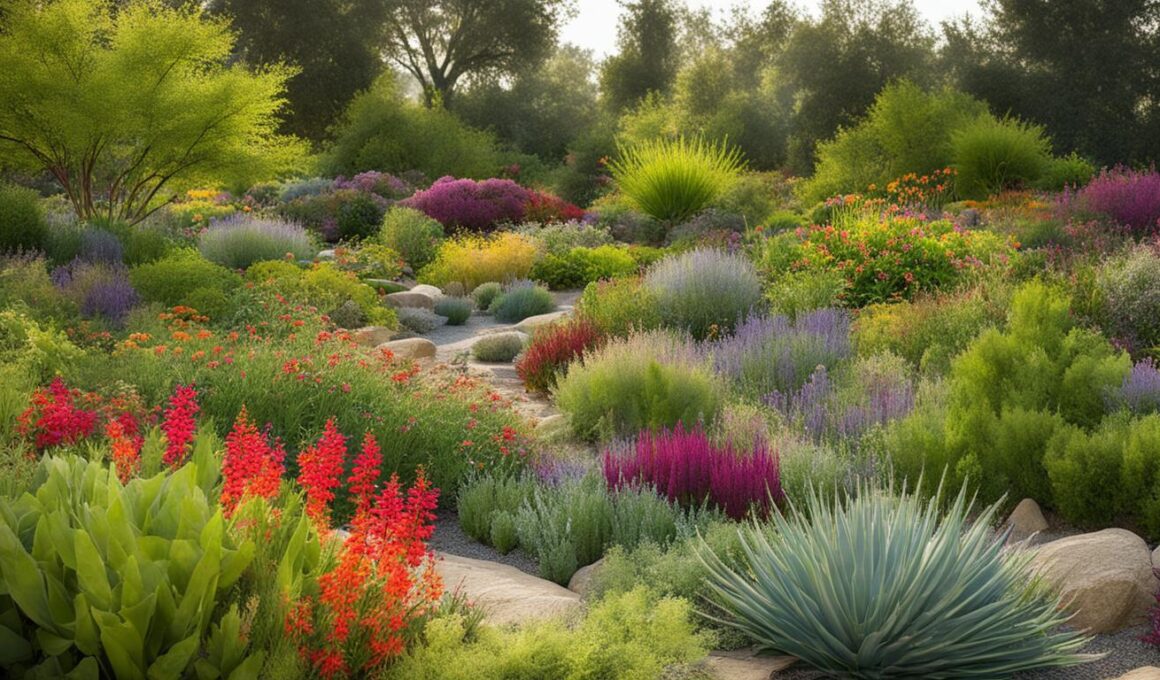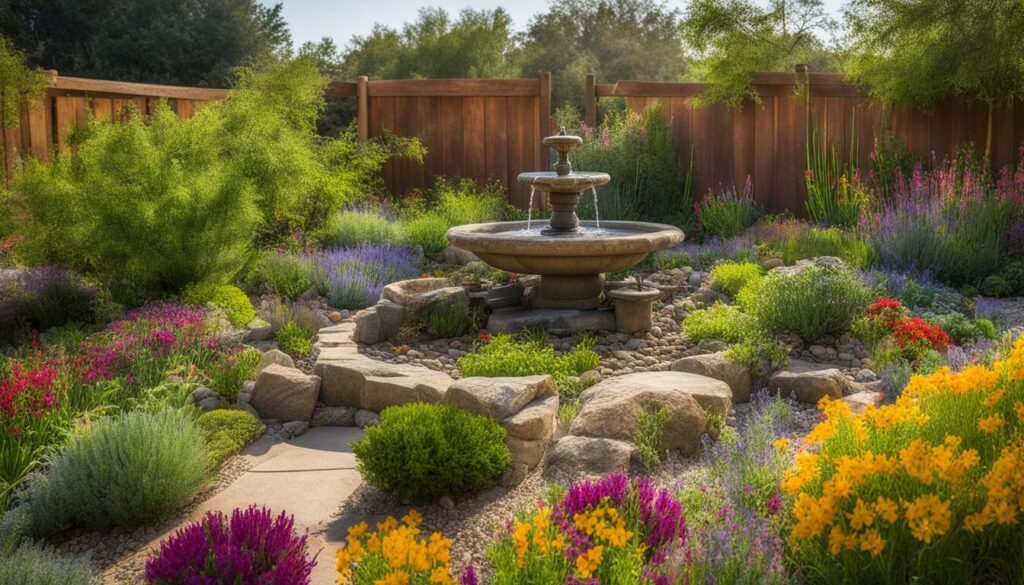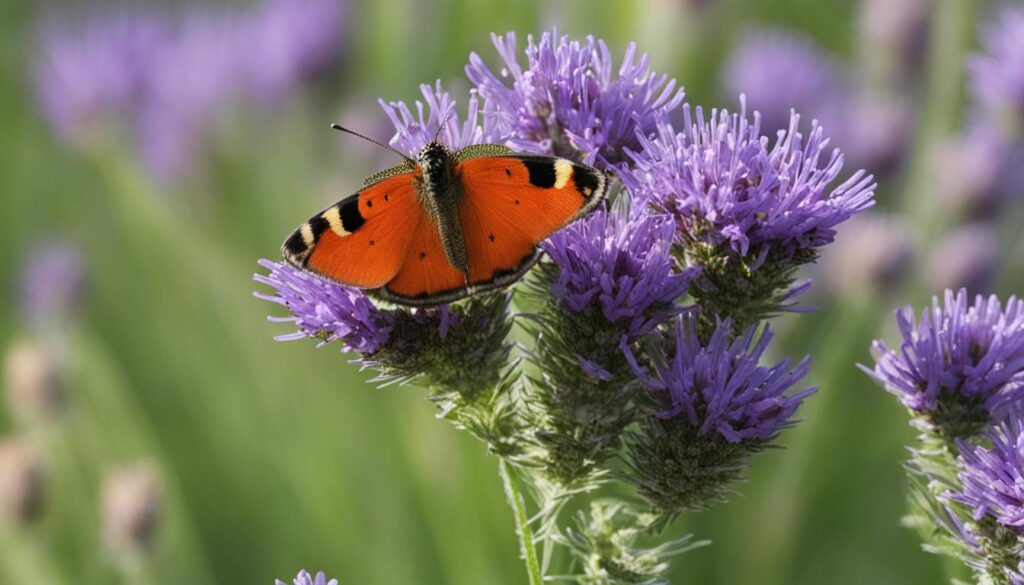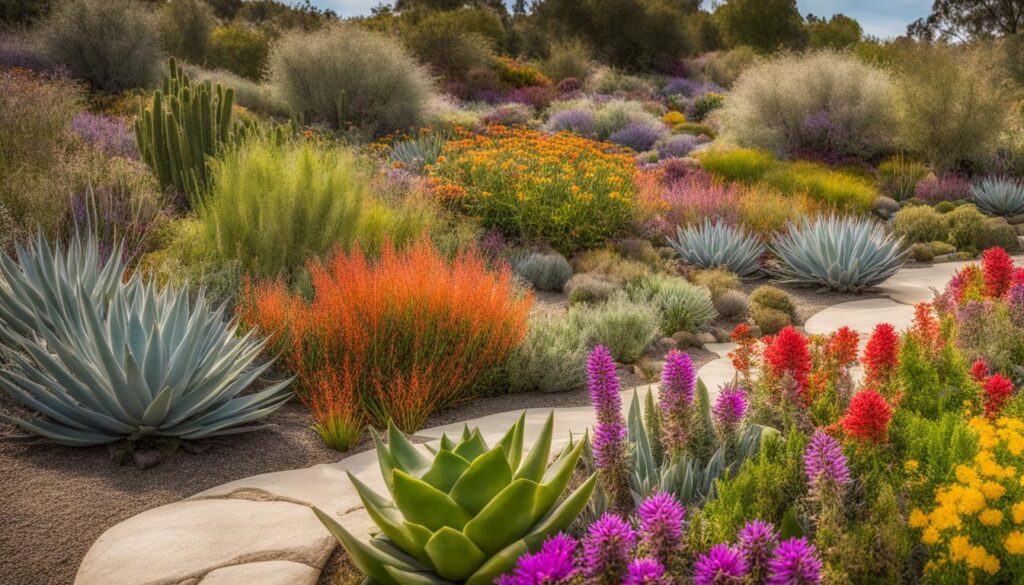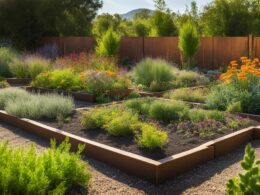Are you looking for ways to transform your garden into an environmentally friendly and low-maintenance space? Incorporating native plants and implementing sustainable practices can help you achieve just that. In this article, we will explore the benefits of gardening with native plants, including water savings, reduced maintenance, increased wildlife and biodiversity, landfill waste reduction, pesticide use reduction, and a stronger connection to California’s sense of place.
Key Takeaways:
- Gardening with native plants can lead to significant water savings and reduced maintenance.
- Native plants attract wildlife and promote biodiversity in your garden.
- By using native plants, you can help reduce landfill waste and minimize pesticide use.
- Planting California native plants enhances the sense of place and reflects the environmental history of the land.
- Xeriscaping principles can help create a sustainable and water-efficient garden.
The Benefits of Using Water-Wise Native Plants
When it comes to designing a sustainable and low-maintenance garden, incorporating water-wise native plants offers numerous benefits. Not only do these plants thrive in their natural habitat, but they also contribute to water savings and reduced maintenance. By choosing water-wise native plants, you can create a beautiful and environmentally friendly landscape that requires minimal watering and upkeep.
One of the key advantages of using water-wise native plants is the significant water savings they offer. Compared to traditional landscapes with turf and high-water use plants, a properly designed drought-tolerant native garden can use up to 85 percent less water per year. Once established, many native plants require little additional watering beyond normal rainfall, making them ideal for regions with limited water resources.
In addition to water savings, water-wise native plants also reduce the need for extensive maintenance. Unlike high-water use plants that require frequent watering and fertilizing, native plants are adapted to local conditions and require minimal care. This means less time spent on mowing, fertilizing, and watering, allowing you to enjoy your garden and other activities.
By choosing water-wise native plants for your garden, you not only create a beautiful and sustainable landscape but also contribute to water conservation and reduced maintenance. The next section will explore how native plants support wildlife and biodiversity, further enhancing the ecological value of your garden.
Supporting Wildlife and Biodiversity with Native Plants
Gardening with native plants not only enhances the beauty of your garden but also plays a crucial role in supporting wildlife and biodiversity. Native plants have evolved over time to thrive in the local climate, soil conditions, and ecosystem, making them highly beneficial for attracting and sustaining native insects, birds, and small mammals. By incorporating native plants into your landscape, you can create a flourishing ecosystem that contributes to the overall health and balance of the environment.
Promoting Native Pollinators and Fruit Production
One key benefit of using native plants is their ability to attract native pollinators, such as bees, butterflies, and hummingbirds. These pollinators play a vital role in fertilizing plants, which in turn leads to improved fruit and vegetable production. By providing a habitat with an abundance of native flowers and nectar sources, you can attract a diverse range of pollinators and ensure the successful pollination of your garden crops.
Natural Pest Control and Pest Management
Another advantage of gardening with native plants is their ability to attract beneficial insects and animals that help control pests naturally. These natural predators, including ladybugs, lacewings, and birds, feed on harmful insects, reducing the need for chemical pesticides. By creating a habitat that supports a diverse array of native wildlife, you can establish a balanced ecosystem where pest populations are kept in check, leading to healthier plants and a more sustainable garden.
Preserving Native Ecosystems and Habitat
Using native plants in your garden not only benefits the immediate area but also contributes to the preservation of native ecosystems and habitat. As urbanization and habitat loss continue to threaten biodiversity, every garden that incorporates native plants helps provide valuable resources and refuge for native wildlife. By creating small patches of native habitat, you can contribute to the larger collective that supports and sustains a diverse range of species, ensuring their survival for future generations.
Reducing Landfill Waste with Native Plant Gardening
One of the significant advantages of gardening with native plants is the reduction in landfill waste. Traditional landscaping practices, such as mowing lawns and trimming hedges, generate a substantial amount of green waste that often ends up in landfills. However, by adopting a native plant gardening approach, you can significantly minimize the amount of green waste produced, making it more environmentally friendly and sustainable.
Native plants typically require less maintenance compared to non-native species. They have adapted to the local climate and soil conditions, making them more resilient and less dependent on fertilizers and pesticides. As a result, you’ll have fewer grass clippings, tree trimmings, and other plant debris to dispose of, significantly reducing the quantity of waste that goes to landfills.
Native plant gardening reduces landfill waste by reducing overall landscape maintenance. By switching to native plants, which require less maintenance, you can significantly reduce the amount of green waste produced.
Furthermore, native plants have deeper root systems that help improve soil health and water absorption. These plants capture and store rainwater more efficiently, reducing the need for watering and preventing excess water runoff that can carry pollutants into waterways. This water-wise approach not only conserves water but also reduces the need for plastic irrigation systems, which are commonly disposed of as waste.
Benefits of Native Plant Gardening in Reducing Landfill Waste:
- Reduces overall landscape maintenance
- Minimizes the amount of green waste generated
- Improves soil health and water absorption
- Conserves water and reduces reliance on plastic irrigation systems
| Traditional Landscaping | Native Plant Gardening | |
|---|---|---|
| Green Waste | High | Low |
| Water Usage | High | Low |
| Plastic Irrigation Systems | Often used | Reduced or unnecessary |
Pesticide Use Reduction with Native Plants
Native plants offer a natural and effective solution for reducing pesticide use in your garden. With their inherent ability to resist pests and diseases, they can help create a balanced ecosystem that minimizes the need for chemical interventions. By choosing native plants, you can protect the health of your garden, the surrounding environment, and even your own well-being.
The Benefits of Natural Pest Control
Native plants have co-evolved with local insects and wildlife, resulting in a harmonious relationship where natural pest control mechanisms become more prevalent. By attracting beneficial insects and animals that prey on pests, native plants provide a natural defense system for your garden. Ladybugs, lacewings, and hummingbirds are just a few examples of the many beneficial creatures that native plants can attract. These natural pest controllers help keep your garden free from harmful pests without the need for synthetic pesticides.
“Native plants provide a natural defense system for your garden, attracting beneficial insects and animals that prey on pests.”
Furthermore, native plants produce chemicals and emit scents that repel certain pests, helping to deter them without the use of chemicals. This natural resistance reduces the likelihood of pest infestations and the subsequent need for pesticide applications. By fostering a diverse range of native plants in your garden, you can maximize the effectiveness of natural pest control processes and minimize the risks associated with chemical pesticides.
Creating a Pest-Resistant Garden
When designing your garden, consider incorporating a variety of native plants to attract a diverse array of beneficial insects and animals. Research which native plants are known to repel specific pests and strategically place them in areas where pest problems are likely to occur. Additionally, maintaining healthy soil, providing appropriate watering, and practicing good garden hygiene can further enhance the overall resilience of your garden and reduce the need for pesticide treatments.
By prioritizing native plants and embracing natural pest control methods, you can create a garden that thrives without relying on harmful pesticides. Not only will you protect the health of your garden ecosystem, but you will also contribute to the preservation of biodiversity and the overall well-being of our planet.
Table: Native Plants for Natural Pest Control
| Native Plant | Pest Repelled |
|---|---|
| Yarrow | Ants, aphids, beetles |
| Borage | Cabbage worms, tomato hornworms |
| Lavender | Mosquitoes, fleas |
| Marigold | Nematodes, whiteflies |
| Pennyroyal | Ants, fleas, mosquitoes |
| Chives | Japanese beetles, aphids |
Note: This table provides examples of native plants and the pests they repel. Incorporating these plants into your garden can help naturally control pests, reducing the need for pesticides. Consult local experts or resources for specific recommendations based on your geographical region.
Enhancing the Sense of Place with California Native Plants
Planting a garden with California native plants creates a stronger sense of place and connection to the natural world. Native plants reflect the unique biological web created by the environmental history and culture of the land. These small patches of habitat contribute to a larger collective that nurtures and sustains a living landscape. By including native plants in your garden, you can create a sanctuary not only for yourself but for the plants, insects, birds, and animals that have always been a part of the land.
California native plants are deeply rooted in the state’s environmental history. They have adapted to the specific climate, soil conditions, and ecosystems of California, making them well-suited for local gardens. By choosing native plants, you are supporting the preservation of California’s biodiversity and the unique characteristics that make the state so special.
“California’s incredibly diverse native flora reflects the dramatically varied landscapes it encompasses, from the coast to the deserts and the mountains in between. By incorporating these plants into our gardens, we can create spaces that not only celebrate the beauty of our state but also support the intricately intertwined web of life that depends on these plants for survival.”
Creating a garden filled with California native plants allows you to experience the natural beauty that has shaped the state over thousands of years. Imagine sitting in your garden, surrounded by vibrant wildflowers, majestic oak trees, and the gentle buzz of pollinators. The scents, colors, and textures of native plants bring a sense of authenticity and harmony to your outdoor space, transporting you to the diverse landscapes of California.
Benefits of Incorporating California Native Plants:
- Preserves California’s biodiversity
- Supports local ecosystems
- Reduces water usage
- Attracts native wildlife
- Requires less maintenance
- Reflects California’s unique environmental history
Xeriscaping: The Practice of Water-Wise Landscaping
Xeriscaping is a sustainable landscaping practice that focuses on reducing water usage and promoting environmental stewardship. By implementing xeriscaping principles, you can create a beautiful and low-maintenance outdoor space while conserving water resources.
One of the key aspects of xeriscaping is proper planning and design. This involves evaluating the site conditions, such as soil type, sun exposure, and drainage, to determine the best plant selection and layout. By choosing native plants that are adapted to the local climate, you can reduce water requirements and ensure their resilience in the landscape.
In addition to plant selection, soil improvement is crucial for xeriscaping. Amending the soil with organic matter improves its water-holding capacity and drainage, allowing plants to thrive even during dry periods. It also helps to mulch the soil surface, which reduces evaporation and suppresses weed growth.
| Principles of Xeriscaping | Benefits |
|---|---|
| Water-efficient irrigation | Reduces water consumption and promotes plant health |
| Minimizing turf areas | Reduces water and maintenance requirements |
| Using mulches | Conserves soil moisture and suppresses weeds |
| Appropriate plant selection | Ensures plant suitability and reduces water needs |
| Soil improvement | Enhances water retention and improves plant growth |
Efficient irrigation is another important aspect of xeriscaping. Drip irrigation systems or smart controllers help deliver water directly to the plant’s root zone, reducing evaporation and minimizing water waste. This targeted approach ensures that plants receive the necessary moisture without overwatering.
By minimizing turf areas in your landscape, you can significantly reduce water requirements. Turfgrass is typically a high-water-use plant, and replacing it with drought-tolerant native plants can result in substantial water savings. Additionally, native plants require less maintenance, such as mowing and fertilizing, further reducing the overall maintenance demands of your garden.
With xeriscaping, you can create a sustainable and water-efficient landscape that not only conserves water resources but also enhances the beauty of your outdoor space. By incorporating these practices, you can create an eco-friendly garden that thrives even in arid conditions.
Conclusion
Gardening with native plants and implementing xeriscaping principles can transform your garden into a sustainable and low-maintenance oasis. By incorporating water-wise native plants, reducing reliance on turf areas, and using efficient irrigation systems, you can save water, reduce maintenance, attract wildlife, and enhance your connection to the natural world. Follow these tips to create a stunning and eco-friendly garden that reflects California’s unique landscapes.
By embracing a native plant xeriscape approach, you can enjoy the numerous benefits it brings. Not only will you save water, but you’ll also reduce maintenance tasks such as mowing, fertilizing, and frequent watering. This frees up your time to simply relax and enjoy your garden, or pursue other activities you love. Native plants also have a positive impact on wildlife and biodiversity, attracting pollinators, beneficial insects, birds, and small mammals to manage pests and promote a healthier garden.
In addition to these environmental benefits, native plant gardening contributes to landfill waste reduction by minimizing the amount of green waste produced. Traditional maintenance practices, like mowing lawns, often generate significant amounts of this waste, which ends up in landfills. Switching to native plants that require less maintenance can significantly reduce your ecological footprint and promote a more sustainable approach to gardening. Furthermore, by relying on the natural defenses of native plants, you can minimize or eliminate the need for pesticides, protecting both the environment and human health.
Lastly, by incorporating California native plants into your garden, you create a stronger sense of place and connection to the natural world. These plants reflect the environmental history and unique cultural heritage of the land, establishing a sanctuary for not only yourself but for the native plants, insects, birds, and animals that have always been a part of your surroundings. So, embrace the native plant xeriscape approach and transform your garden into a beautiful and environmentally friendly space that requires minimal upkeep.





